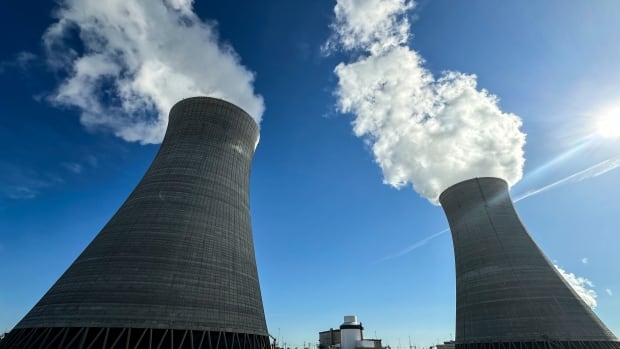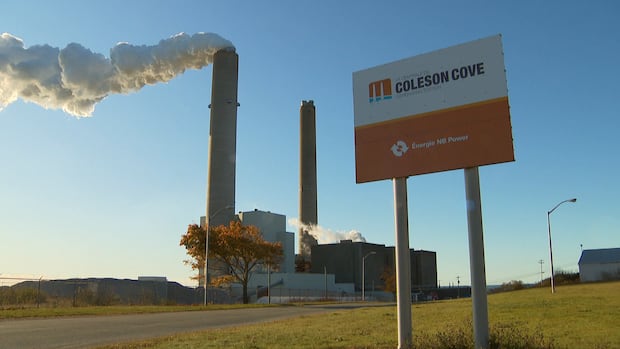Governments in Canada, the U.S. and abroad along with tech giants are all eyeing nuclear power to meet a growing demand for electricity and climate goals at the same time.
Just days ago, the U.S. announced plans to triple its nuclear capacity by 2050. Tech giants Google, Amazon and Microsoft are tapping nuclear to support their power hungry AI services.
Closer to home, Ontario is refurbishing old nuclear plants and building new ones. There has also been interest in building new nuclear plants in New Brunswick, Alberta, Saskatchewan and Quebec.
Abroad, China has more than doubled its nuclear power capacity in the past decade. The World Nuclear Association says dozens of other countries are considering, planning or starting nuclear power programs. At the UN climate summit COP29 this month, six more countries signed a declaration to triple nuclear energy by 2050, bringing the total signatories to 31.
Here’s a closer look at why there seems to be renewed interest in nuclear, despite the rise of cheap wind and solar.
Pickering Nuclear Generating Station is one of the largest nuclear power stations in the world. CBC’s Mike Crawley got a rare tour of the plant, off limits to the general public.
Coming back from decline
Nuclear has had its ups and downs. A large number of new reactors were built in the 1970s and 1980s. Then in 1986, the worst nuclear disaster in history occurred at Chernobyl in northern Ukraine. More than 30 workers and firefighters died and a 30-kilometre radius around the plant was left uninhabitable by the radiation released, making the public around the world leery of nuclear.
Globally, the share of electricity generated from nuclear power has shrunk since the mid-1990s, from more than 17 per cent to around nine per cent, according to Our World In Data and Ember, a clean energy think-tank. Reactors built decades earlier were starting to retire, IEA data shows.
Then, in 2011, a huge earthquake and tsunami damaged three reactors at the Fukushima Daiichi Nuclear Power Plant in Japan, releasing radiation and forcing the evacuation of 154,000 people. Although the accident caused no known injuries, illnesses or deaths, it dampened the public’s support for nuclear power again.
Japan suspended operations at 46 of its 50 operational nuclear reactors. Germany and Belgium decided to phase out nuclear power. Spain and Switzerland decided not to build new nuclear plants.
In fact, Chernobyl was the only nuclear accident to result in any deaths of workers or members of the public from radiation exposure in the past 60 years, reports the World Nuclear Association. That’s despite the fact that if you added together the operating time of nuclear reactors in 36 countries around the world in those decades, it would total 18,500 years.
Christopher Gully, vice-president of communications and member engagement at the Canadian Nuclear Association, said “misconceptions and fears” about nuclear safety and the potential to use the technology to make nuclear weapons led people to shy away from nuclear power.
“And also, frankly, there were very cheap alternatives in the form of natural gas and coal.”
But burning those fossil fuels for electricity generates carbon emissions and is the main cause of climate change. Many countries including Canada have pledged to achieve net-zero emissions by 2050 and turn to non-emitting power generation.
One of the reasons nuclear has recently received renewed attention is because it doesn’t emit carbon dioxide, said Gully. “But I think the other thing that is becoming clear is the role of nuclear in providing energy security.”
In 2022, Russia’s invasion of Ukraine led to a spike in natural gas prices and energy security fears among European countries relying on fossil fuel imports, especially natural gas from Russia.
A need for carbon-free options
Efforts to electrify vehicles, home heating and industrial processes are driving up demand for electricity.
Jason Dion, senior research director for the Canadian Climate Institute, said that surge caught many utilities and governments by surprise, and led to “more openness to nuclear.” In the U.S., polling shows public support for nuclear dropped after the Fukushima accident, but has been trending up since 2016.
The climate advantage of nuclear has also caught the eye of industries that use lots of electricity, such as technology and AI.
In September, tech giant Microsoft and Constellation Energy announced a partnership to restart a reactor at Three Mile Island in Middletown, Pa., site of a nuclear accident in 1979 that is considered the worst in U.S. history.
In the announcement, Constellation president and CEO Joe Dominguez said industrial facilities such as data centres require an “abundance of energy that is carbon-free and reliable every hour of every day.” Amazon and Google are also investing in nuclear.
The energy needed to generate artificial intelligence leaves behind a sizable carbon footprint, but it’s also increasingly being used as a tool for climate action. CBC’s Nicole Mortillaro breaks down where AI emissions come from and the innovative ways the technology is being used to help the planet.
‘Most expensive part of a cheap electricity system’
Despite the shifting stance on nuclear power, it still faces hurdles. One of the major arguments against it has been the huge upfront cost of building a reactor, while the cost of alternatives such as wind and solar keeps falling.
“Nuclear is expensive and I don’t think anyone would claim otherwise,” Gully said.
For example, Ontario’s four-unit Darlington nuclear station, completed in 1993 after more than a decade of construction and delays, cost $14.5 billion to build, about double the initial estimate. However, it has operated reliably for decades, and currently supplies 20 per cent of the province’s electricity — enough for two million households. It’s undergoing a $12.8-billion refurbishment so it can operate until 2055.
Refurbishments at Darlington and the larger Bruce nuclear station are ahead of schedule and under budget, Gully said.
There can also be other costs later. New Brunswick’s nuclear plant has been offline since a maintenance shutdown in April led to other issues, racking up more than $100 million in costs by September.
N.B. Power is being forced to run its pricey oil-fired generator at Coleson Cove hard this fall as a shutdown at the Point Lepreau nuclear generating station passes its 200th day.
And, of course, there are costs and issues related to waste management. Neither Canada nor the U.S. have yet built long-term storage for their nuclear waste — all the waste ever generated is still stored at the nuclear power stations despite decades of operation. A decision on the location of Canada’s nuclear waste repository is expected by the end of this year.
WATCH | Where will Canada put its forever nuclear waste dump?:
Those against building new nuclear plants, such as the Ontario Clean Air Alliance, say that lack of long-term storage poses a danger. The group also argues that nuclear is too slow and too expensive to build, and wind, solar and storage should be able to meet the province’s power needs.
Nuclear has some advantages over renewables like wind and solar. It requires less land, and it can produce reliable electricity 24/7, which may be important for some regions or businesses, said John Bistline, a researcher who models energy systems at the U.S. energy think-tank Electric Power Research Institute (EPRI).
When part of a mixed power system with intermittent sources such as wind and solar, batteries and other energy storage, nuclear can add stability and help balance supply and demand, bringing down the costs for the entire system, said Gully.
“So it’s the most expensive part of a cheap electricity system.”
But the decarbonization of the energy system needs to go beyond the electricity grid, said Steve Changelis, senior director of future nuclear at EPRI.
The heat produced by a nuclear plant could supply district heating for buildings and be used for industrial processes and manufacturing, he said.
Relative cost of nuclear shifting
Nuclear plants operate for decades, and in the long-term, the cost to produce nuclear electricity in Ontario was reported to be comparable to solar, hydro and natural gas in 2018, but greater than wind. In other countries, such as Sweden, Switzerland and France, the cost of nuclear power is competitive with wind, IEA data shows.
Meanwhile, it’s becoming increasingly expensive to use fossil fuels to generate electricity. As countries aim to meet climate targets, some are imposing carbon taxes, carbon tariffs and other regulations to encourage the transition to lower emissions technologies.
“The economics are shifting,” Gully said. “Fossil fuel power generation … is only going to get more expensive. Nuclear is going to either stay the same or get cheaper.”
Changelis is looking at some strategies to bring down the cost of nuclear, such as siting new reactors at old fossil fuel power plants already connected to transmission lines.
Saskatchewan is counting on nuclear power to be a major part of its future power generation but the technology the province is hoping to lean on is costly and not yet operational in Canada. Recently, federal government officials announced money for small modular nuclear reactors but the provincial government and SaskPower were not there to hear it. The province says the details of the funding agreement have not yet been finalized.
Small modular reactors (SMRs) are also being developed. These scaled-down reactors are smaller in size and, theoretically, price compared to traditional nuclear plants.
Both New Brunswick and Ontario are investing in SMRs, but have been criticized for not releasing cost estimates. New Brunswick’s reactors are delayed past 2030, as one company contracted to build them faced a sudden leadership change in June.
Dion, from the Canadian Climate Institute, noted that since there aren’t any functioning SMRs yet in Canada or abroad, how big a role they will play in future electricity grids “remains to be seen.”
However, he and others interviewed think traditional nuclear will be a key part of future carbon-free grids, alongside renewables and energy storage.
Energy systems, Dion said, “are going to have to get bigger, cleaner and smarter and all across the country and around the world. That’s really motivating, kind of an all-of-the above approach to electricity systems and supply.”





